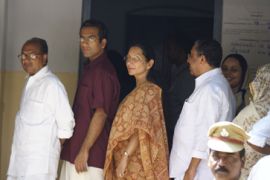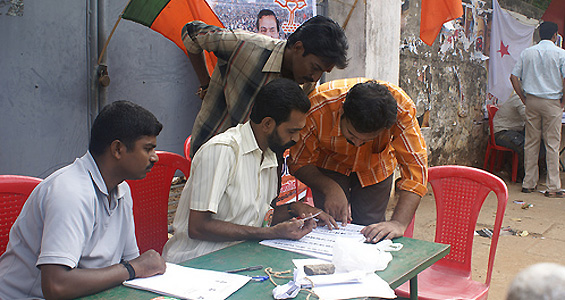Wealthy Indians boost turnout
Despite some violence, the first phase of the poll recorded 58-62 per cent turnout.


What was unusual was the large turnout of middle and upper class voters in urban areas, who traditionally stay indoors treating polling day as any other public holiday
As expected, the Maoists made their presence felt in the first phase of India’s general election.
The constituencies that went to the polls on Thursday in the five-phase exercise were mostly in the so-called Red Corridor districts spread across several states.
The election commission decided on grouping them together in order to deal with the most difficult districts first.
However, despite the violence that claimed 19 lives, the first phase recorded a voter turnout of between 58 and 62 per cent.
What was unusual was the large turnout of middle and upper class voters in urban areas.
| In depth |
 Features and analyses on India’s general election
|
The tradition in India so far has been that the poor come out in large numbers while the rich stay indoors, treating polling day as any other public holiday.
In the last four general elections, the poor voted more than the upper classes, and since 1977, rural areas have recorded higher turnouts than the cities.
This trend is in stark contrast to the European and North American experience, where the assumption has been that political participation is a function of social privilege.
If you are rich, well-educated and belong to a majority within the community, then you are more likely to vote and participate in political activity.
This Western pattern is now emerging in India’s cities and it was in evidence in Thiruvanathapuram and Hyderabad – the first big city to vote.
Casting aside their alleged indifference, the urban middle class stepped out like never before and the inked index finger – the sign of having voted – has become a symbol to flaunt.
So, what has changed?
G Krishnan, a businessman staying in an up-market part of Hyderabad, says “the awareness campaigns over the past few weeks and a new-found enthusiasm for the political process among the young” have been key.
Polling booths in areas such as Jubilee Hills and Banjara Hills near the city’s information technology hub saw an estimated 30 per cent rise in voter turnout.
Flawed democracy?
Political awareness is certainly rising, but at the same time, a report by the Economist Intelligence Unit recently described India as a flawed democracy.
The unit’s 2008 Democracy index, based on 60 indicators, ranked India 35 out of 167 countries, putting it among the 50 countries considered “flawed democracies”.
This designation includes neighbouring states such as Sri Lanka, Thailand, the Philippines, Indonesia and Malaysia, as well as the rapidly emerging market giant, Brazil.
Still, India ranks above all of these nations and, with an overall score of 7.8 out of 10, it is just shy of the score needed to be categorised as a full democracy.
Manoj Vohra, director of research with the Economist Intelligence Unit, says: “While India’s democracy, in technical terms, is flawed, the country is very close to joining the elite club of full democracies.
“India’s young citizenry needs to engage with politics more actively and constructively in order to create a favourable democratic culture in the country.”
India’s relatively strong position on the index owes much to its high scores in the electoral process, pluralism and civil liberties categories.
Political participation
India does not fare well in the categories of political participation and political culture.
Nobel laureate Amartya Sen’s “argumentative Indian” may facilitate public debate, but it seems that has not translated into a high level of political participation so far.
So are Indians indifferent to voting in particular and politics in general?
If we examine turnout for elections for the Lok Sabha (lower house of parliament)from a global perspective, India is among the lower middle category.
The global average of turnouts among electoral democracies since the second world war is about 65 per cent.
At 57 per cent, India is way behind the established democracies in Western Europe, but substantially ahead of the US and most of South America.
If the new-found interest in politics along with the election commission’s attempt to prune the electoral rolls of bogus voters is anything to go by, an improved voter turnout this time will put India close to the global average.
And the turnout in the first phase is a potent indicator.
‘Democratic upsurge’
“We are in the midst of a democratic upsurge, of the kind that could become a model in the history of democracy,” says Yogendra Yadav, a senior poll analyst.
Another indicator is that there has been no steady decline in voter turnout in India. It has either remained stable or has spiked at times.
The lowest turnout in a Lok Sabha election, 45.7 per cent, was recorded in the very beginning in 1952. The highest, 64.1 per cent, was in 1985. The last elections in 2004 saw 58.1 per cent of voters turning out to press electronic voting machine buttons.
National voter turnout figures in general elections also mask extremely wide inter-state variations, ranging from 35 per cent in Jammu and Kashmir to 92 per cent in the small north-eastern state of Nagaland.
